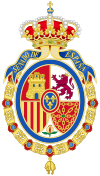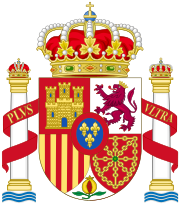Senate of Spain
Senate Senado | |
|---|---|
| XI Legislature | |
 | |
| Type | |
| Type | |
| History | |
| Founded | 1837 (disband 1923-1977) 1978 (reinstituted) |
| Leadership | |
First Vice President | |
Second Vice President | |
Majority leader | José Manuel Barreiro (PP) |
Minority leader | Marcelino Iglesias (PSOE) |
| Structure | |
| Seats | 266 |
 | |
Political groups | Government (145)
Opposition (121) |
| Meeting place | |
 | |
| Palacio del Senado Centro, Madrid Kingdom of Spain | |
| Website | |
| www.senado.es | |
The Senate (Spanish: Senado) is the upper house of Spain's parliament, the Cortes Generales. It is made up of 266 members: 208 elected by popular vote, and 58 appointed by the regional legislatures. All senators serve four-year terms, though regional legislatures may recall their appointees at any time.
The last election was held on 20 December 2015. The composition of the 11th Senate, which cannot serve beyond 2020, is:
| Political party/group | Elected | Appointed | Total | |
|---|---|---|---|---|
| People's Party | 124 | 21 | 145 | |
| Spanish Socialist Workers' Party | 47 | 20 | 67 | |
| style="background-color: Template:Podemos (Spanish political party)/meta/color"| | Podemos | 16 | 7 | 23 |
| style="background-color: Template:Democracy and Freedom/meta/color"| | Democracy and Freedom | 6 | 2 | 8 |
| style="background-color: Template:Republican Left of Catalonia/meta/color"| | Republican Left of Catalonia | 6 | 2 | 8 |
| Basque Nationalist Party | 6 | 1 | 7 | |
| style="background-color: Template:Citizens (Spanish political party)/meta/color"| | Citizens | 0 | 3 | 3 |
| style="background-color: Template:Canarian Coalition/meta/color"| | Canarian Coalition | 1 | 1 | 2 |
| style="background-color: Template:Euskal Herria Bildu/meta/color"| | Euskal Herria Bildu | 0 | 1 | 1 |
| Cambio-Aldaketa | 1 | 0 | 1 | |
| Gomera Socialist Group | 1 | 0 | 1 | |
| Total | 208 | 58 | 266 | |
History
The Spanish senate was instituted by the constitution of 1837 under the regency of Maria Christina of the Two Sicilies. It remained under the regimes of the constitutions of 1845, 1856, 1869 and 1876. It was composed, at that latter time, of three main categories: senators by their own right, senators for life and senators elected. This chamber was suppressed after the coup of General Miguel Primo de Rivera in 1923.
Only after the Spanish transition to democracy in 1978 was it re-instituted.
Organization
Senators form groups along party lines. Parties with fewer than ten senators form the Mixed Group. If the membership of an existing group falls below six during a session, it is merged into the Mixed Group at the next session. For example, Coalición Canaria lost its senate caucus in 2008 after electoral losses reduced its group from six to two. The Basque Nationalist Party, falling from seven to four, "borrowed" senators from the ruling Socialist Party to form their group; in exchange, they supported the election of socialist Javier Rojo as President of the Senate. The PNV group is again under threshold after returning the borrowed Socialists, and it faces dissolution after the current session.
Legally, 133 seats are required for an absolute majority, vacant seats notwithstanding.
 |
|---|
Elections to the Senate
To date, senate elections have coincided with elections to the lower house, but the President of the Government (i.e., the Prime Minister) may legally advise the king to call elections for one chamber only, under article 115 of the Spanish Constitution. While the Congress of Deputies is chosen by party list proportional representation, the members of the senate are chosen in two distinct ways: popular election by partial block voting and appointment from regional legislatures.
Directly elected members
Most members of the senate (currently 208 of 266) are directly elected by the people. Each province elects four senators without regard to population. Insular provinces are treated specially. The larger islands of the Balearics (Baleares) and Canaries (Canarias) – Majorca, Gran Canaria, and Tenerife – are assigned three seats each, and the smaller islands - Minorca, Ibiza-Formentera, Fuerteventura, Gomera, Hierro, Lanzarote and La Palma – one each; Ceuta and Melilla are assigned two seats each. This allocation is heavily weighted in favor of small provinces; Madrid, with roughly 6 million people, and Soria, with 100,000 inhabitants, are each represented by four senators.
In non-insular constituencies, each party nominates three candidates. Candidates' names are organized in columns by party on a large (DIN A3 or larger) ochre-colored ballot called a sábana or bedsheet.
Each voter may mark up to three candidates' names, from any party. This is the only occasion when Spanish voters vote for individuals rather than a party list. Panachage is allowed, but typically voters cast all three votes for candidates of a single party. As a result, the four Senators are usually the three candidates from the most popular party and the first placed candidate from the next most popular.
Before 2011, a party couldn't choose the order of its candidates on the ballot paper; candidates were sorted alphabetically by surname. When a party didn't got all three of its candidates elected, this arrangement favored candidates with surnames early in the alphabet. This was the case for 2nd placed parties in every province and for both parties in tight races when voters didn't vote for three candidates of the same party (panachage).
Regional legislatures-appointed members
Article 69.5 of the Spanish Constitution empowers the legislative assembly of each autonomous community of Spain to appoint a senate delegation from its own ranks, with one Senator per one million citizens, rounded up. Demographic growth increased the combined size of the regional delegations from 51 to 56 in 2008 for the 9th term.
Conventionally, the proportions of the regional delegations mimic their legislative assemblies, as required in principle by Article 69.5 of the constitution. However, Autonomous Communities have considerable leeway, and a motion to appoint the delegation often requires no more than a plurality. Two anomalous examples are:
- After the 2007 election, the single senator from the Balearic Islands was from neither the largest bloc (the People's Party, with 28 of 59 seats), nor the second-largest (the PSOE, with 16), but in fact from the fourth-largest bloc, the Socialist Party of Majorca, which held only four of 59 seats. This arrangement was part of a five-party coalition agreement. This anomaly was resolved in 2008, when the Balearic Islands gained a second senate seat which was filled by the PP.
- Since 2003, the PSOE has ruled Aragon with support from regionalist parties. In the 2007 election, it won 30 of 67 seats. Nevertheless, Aragon's two appointed senators came from the opposition People's Party (23 seats) and the regionalist Aragonese Party (9 seats).
Due to population growth, Andalusia, the Balearic and Canary Islands, Catalonia, and Madrid each gained a new senator in 2008. Andalusia was the last Autonomous Community to allocate its new seat; it rebuilt its entire delegation after its 2008 regional elections. The current distribution is:
| Autonomous Community | Population (2011) | Senators | Senator/pop.-ratio | Distribution |
|---|---|---|---|---|
| Andalusia | 8,059,461 | 9 | 895,496 |
|
| Aragón | 1,296,655 | 2 | 648,328 | |
| Asturias | 1,074,862 | 2 | 537,431 | |
| Balearic Islands | 1,030,650 | 2 | 515,325 | |
| Canary Islands | 2,025,951 | 3 | 675,317 | |
| Cantabria | 572,824 | 1 | 572,824 | |
| Castilla - La Mancha | 2,000,000+ | 3 | 666,667 (roughly) | |
| Castilla y León | 2,528,417 | 3 | 842,806 | |
| Catalonia | 7,210,508 | 8 | 901,314 |
|
| Valencian Community | 5,000,000+ | 6 | 833,333 (roughly) | |
| Extremadura | 1,089,990 | 2 | 544,970 | |
| Galicia | 2,772,533 | 3 | 924,178 | |
| Madrid | 6,081,689 | 7 | 868,812 |
|
| Murcia | 1,392,117 | 2 | 696,059 | |
| Navarre | 605,876 | 1 | 605,876 | |
| Basque Country | 2,141,860 | 3 | 713,953 | |
| La Rioja | 308,968 | 1 | 308,968 | |
| Total | 45.200.737 | 58 | 779.323 | Source: [1] |
Key:
- People's Party
- Socialist
- Convergence and Union
- Catalan Agreement of Progress (PSC/ICV)
- Basque Nationalist Party
- Other
- Vacant
Role
The Spanish parliamentary system is bicameral but asymmetric. The Congress of Deputies has more independent functions, and it can also override most Senate measures. Only the Congress can grant or revoke confidence to a Prime Minister. In the ordinary lawmaking process, either house may be the initiator, and the senate can amend hostilely or veto, the proposal then being sent back to the lower house, which can override these objections by an absolute majority vote. Organic laws, which govern basic civil rights and regional devolutions, need an absolute majority of both congress and senate to pass.
The process for constitutional amendments is slightly more tangled: the rule is to require a three fifths (60%) of both houses, but if the senate does not achieve such a supermajority and a mixed congress-senate committee fails to resolve the issues, the congress may force the amendment through with a two-thirds vote as long as an absolute majority of the senate was in favour.
On the other hand, the senate has certain exclusive functions in the appointment of constitutional posts, such as judges of the Constitutional Court or the members of the General Council of the Judicial Power. Although it has never exercised this authority, the senate is solely responsible for disciplining regional presidents (article 155 of the Spanish Constitution). Only the senate can suspend local governments. (Local Regime Framework Act article 61.[1]) It exercised this power in April 2006, dissolving the Marbella city council when most of its members were found to have engaged in corrupt practices.
Senate reform has been a topic of discussion since the early days of Spanish democracy. One proposal would advance the federalization of Spain by remaking the senate to represent the autonomous communities of Spain.
Presidents of the Spanish Senate
| Term | President | From | To | Constituency | Political party |
|---|---|---|---|---|---|
| Constituent 1977-1979 |
Antonio Fontán Pérez | July 13, 1977 | January 2, 1979 | Seville | UCD |
| I 1979-1982 |
Cecilio Valverde Mazuelas | April 27, 1979 | August 31, 1982 | Córdoba | |
| II 1982-1986 |
José Federico de Carvajal Pérez | November 18, 1982 | April 23, 1986 | Madrid | PSOE |
| III 1986-1989 |
July 15, 1986 | September 2, 1989 | |||
| IV 1989-1993 |
Juan José Laborda Martín | November 21, 1989 | April 12, 1993 | Burgos | |
| V 1993-1996 |
June 29, 1993 | January 9, 1996 | |||
| VI 1996-2000 |
Juan Ignacio Barrero Valverde | March 27, 1996 | February 8, 1999 | Badajoz | PP |
| Esperanza Aguirre Gil de Biedma | February 8, 1999 | January 18, 2000 | Madrid | ||
| VII 2000-2004 |
April 5, 2000 | October 21, 2002 | |||
| Juan José Lucas Giménez | October 22, 2002 | January 20, 2004 | Castille and León (appointed) | ||
| VIII 2004-2008 |
Francisco Javier Rojo García | April 2, 2004 | January 15, 2008 | Álava | PSE-EE |
| IX 2008-2011 |
April 1, 2008 | December 13, 2011 | |||
| X 2011-2015 |
Pío García-Escudero Márquez | December 13, 2011 | October 27, 2015 | Madrid | PP |
| XI 2016- |
January 13, 2016 | Incumbent |
Notes
